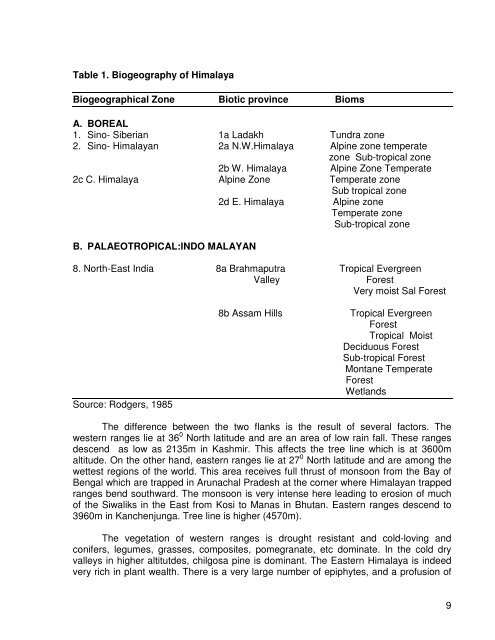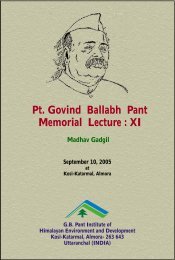Pandit Govind Ballabh Pant Memorial Lecture: II
Pandit Govind Ballabh Pant Memorial Lecture: II
Pandit Govind Ballabh Pant Memorial Lecture: II
You also want an ePaper? Increase the reach of your titles
YUMPU automatically turns print PDFs into web optimized ePapers that Google loves.
Table 1. Biogeography of Himalaya<br />
Biogeographical Zone Biotic province Bioms<br />
A. BOREAL<br />
1. Sino- Siberian 1a Ladakh Tundra zone<br />
2. Sino- Himalayan 2a N.W.Himalaya Alpine zone temperate<br />
zone Sub-tropical zone<br />
2b W. Himalaya Alpine Zone Temperate<br />
2c C. Himalaya Alpine Zone Temperate zone<br />
Sub tropical zone<br />
2d E. Himalaya Alpine zone<br />
Temperate zone<br />
Sub-tropical zone<br />
B. PALAEOTROPICAL:INDO MALAYAN<br />
8. North-East India 8a Brahmaputra Tropical Evergreen<br />
Valley<br />
Forest<br />
Very moist Sal Forest<br />
Source: Rodgers, 1985<br />
8b Assam Hills<br />
Tropical Evergreen<br />
Forest<br />
Tropical Moist<br />
Deciduous Forest<br />
Sub-tropical Forest<br />
Montane Temperate<br />
Forest<br />
Wetlands<br />
The difference between the two flanks is the result of several factors. The<br />
western ranges lie at 36 0 North latitude and are an area of low rain fall. These ranges<br />
descend as low as 2135m in Kashmir. This affects the tree line which is at 3600m<br />
altitude. On the other hand, eastern ranges lie at 27 0 North latitude and are among the<br />
wettest regions of the world. This area receives full thrust of monsoon from the Bay of<br />
Bengal which are trapped in Arunachal Pradesh at the corner where Himalayan trapped<br />
ranges bend southward. The monsoon is very intense here leading to erosion of much<br />
of the Siwaliks in the East from Kosi to Manas in Bhutan. Eastern ranges descend to<br />
3960m in Kanchenjunga. Tree line is higher (4570m).<br />
The vegetation of western ranges is drought resistant and cold-loving and<br />
conifers, legumes, grasses, composites, pomegranate, etc dominate. In the cold dry<br />
valleys in higher altitutdes, chilgosa pine is dominant. The Eastern Himalaya is indeed<br />
very rich in plant wealth. There is a very large number of epiphytes, and a profusion of<br />
9











